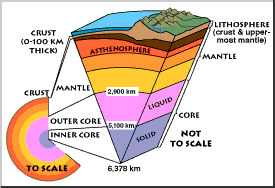
The earth is like a giant jawbreaker composed of several concentric rings or layers. The basis for recognizing these layers is from studying earth waves = seismic waves propagated through the interior.
Earthquakes and explosions create these seismic waves.

What has been learned is that four distinct layers- the crust, mantle, inner and outer core- can be distinguished by seismic waves and their physical behavior.
1. Crust--varies from as little as 5 km to 50 km thick and is rigid, as is the upper portion of the mantle. Oceanic crust is thin and of basaltic composition. Continental crust is thicker and of andesitic to granitic composition.
2. Mantle--The crust is separated from the mantle by the Moho at a depth of ~50 km, seismic waves abruptly increase at the Moho. It is thought that this is due to the mantle being made of a denser type of rock called peridotite.
The mantle continues to a depth of about 2900 km and then another discontinuity is present.
3. Outer Core--At 2900 km the liquid outer core is reached. It is believed to be made of iron and a few percent nickel- this is the composition of iron meteorites. The reason it is believed to be liquid is that seismic waves that can't pass through liquids can't pass through the mantle/outer core boundary.
4. Outer Core--At a depth of 5155 km seismic waves of the type that can pass through liquid suddenly speed up. This indicates that they are passing through a denser solid inner core of Fe/Ni. The inner core has a radius of 1216 km.
The total distance from the crust to the core is 6378 km.

One other way to separate the earth descriptively is into a outer layer of rigid rock called the lithosphere that ends at a depth of 100km and another layer of more plastic rock called the asthenosphere that goes to a depth of at least 350 km ( and perhaps down to 700 km). The reason that the asthenosphere is plastic is that it is partially molten (up to 10 %) and can thus flow.
That the asthenosphere is plastic key to the theory of plate tectonics that states that the rigid lithosphere can move in pieces called plates.